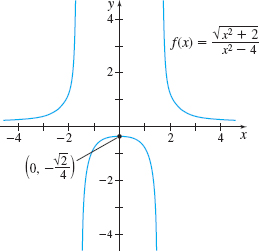EXAMPLE 2Determining Whether a Function Is Continuous at a Number
Determine if f(x)=√x2+2x2−4 is continuous at the numbers −2, 0, and 2.

Figure 23 f is continuous at 0; f is discontinuous at −2 and 2.
Solution The domain of f is {x|x≠−2, x≠2}. Since f is not defined at −2 and 2, the function f is not continuous at −2 and at 2. The number 0 is in the domain of f. That is, f is defined at 0, and f(0)=−√24. Also, lim
The three conditions of continuity at a number are met. So, the function f is continuous at 0.
Figure 23 shows the graph of f.